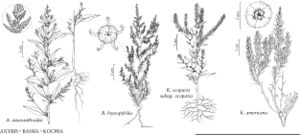Difference between revisions of "Bassia hyssopifolia"
Revis. Gen. Pl. 2: 547. 1891.
FNA>Volume Importer |
imported>Volume Importer |
||
| Line 6: | Line 6: | ||
|place=2: 547. 1891 | |place=2: 547. 1891 | ||
|year=1891 | |year=1891 | ||
| + | }} | ||
| + | |special_status={{Treatment/ID/Special_status | ||
| + | |code=W | ||
| + | |label=Weedy | ||
| + | }}{{Treatment/ID/Special_status | ||
| + | |code=I | ||
| + | |label=Introduced | ||
| + | }}{{Treatment/ID/Special_status | ||
| + | |code=F | ||
| + | |label=Illustrated | ||
}} | }} | ||
|basionyms={{Treatment/ID/Basionym | |basionyms={{Treatment/ID/Basionym | ||
| Line 33: | Line 43: | ||
|elevation=0-1200 m | |elevation=0-1200 m | ||
|distribution=Alta.;B.C.;Ariz.;Calif.;Colo.;Idaho;Mass.;Mont.;Nev.;N.Mex.;N.Y.;Oreg.;S.Dak.;Tex.;Utah;Wash.;Wyo.;Eurasia (e Europe;arid regions of Asia). | |distribution=Alta.;B.C.;Ariz.;Calif.;Colo.;Idaho;Mass.;Mont.;Nev.;N.Mex.;N.Y.;Oreg.;S.Dak.;Tex.;Utah;Wash.;Wyo.;Eurasia (e Europe;arid regions of Asia). | ||
| + | |introduced=true | ||
|discussion=<p><i>Bassia hyssopifolia</i> has been reported from southern Saskatchewan, but H. J. Scoggan (1978–1979, part 3) noted that this record possibly referred to <i>Kochia scoparia</i> (Linnaeus) Schrader. Putative hybrids between <i>B. hyssopifolia</i> and <i>K. scoparia</i> are reported from Utah (S. L. Welsh 1984). Such hybridization is extremely interesting because it has not been reported within the native ranges of those species in Eurasia. I have seen only one specimen that might represent such a hybrid. Its general habit resembles <i>Bassia</i> (including pubescent leaves), but its perianth segments are very variable, with winglike, conic, or almost spinescent appendages.</p> | |discussion=<p><i>Bassia hyssopifolia</i> has been reported from southern Saskatchewan, but H. J. Scoggan (1978–1979, part 3) noted that this record possibly referred to <i>Kochia scoparia</i> (Linnaeus) Schrader. Putative hybrids between <i>B. hyssopifolia</i> and <i>K. scoparia</i> are reported from Utah (S. L. Welsh 1984). Such hybridization is extremely interesting because it has not been reported within the native ranges of those species in Eurasia. I have seen only one specimen that might represent such a hybrid. Its general habit resembles <i>Bassia</i> (including pubescent leaves), but its perianth segments are very variable, with winglike, conic, or almost spinescent appendages.</p> | ||
|tables= | |tables= | ||
| Line 56: | Line 67: | ||
|publication title=Revis. Gen. Pl. | |publication title=Revis. Gen. Pl. | ||
|publication year=1891 | |publication year=1891 | ||
| − | |special status= | + | |special status=Weedy;Introduced;Illustrated |
| − | |source xml=https:// | + | |source xml=https://bibilujan@bitbucket.org/aafc-mbb/fna-data-curation.git/src/bb6b7e3a7de7d3b7888a1ad48c7fd8f5c722d8d6/coarse_grained_fna_xml/V4/V4_595.xml |
|genus=Bassia | |genus=Bassia | ||
|species=Bassia hyssopifolia | |species=Bassia hyssopifolia | ||
Revision as of 23:17, 27 May 2020
Plants 5–100 cm. Stems divaricately branched or simple. Leaves sessile (or sometimes narrowed into pseudopetiole); blade lanceolate-elliptic, lanceolate, or linear, flat, base cuneate. Inflorescences with ± straight axes. Perianth segments with thin, hooked spine adaxially at maturity. 2n = 18.
Phenology: Flowering late summer–fall.
Habitat: Saline habitats, coastal dunes, salt marshes, disturbed habitats, roadsides, fields
Elevation: 0-1200 m
Distribution
Introduced; Alta., B.C., Ariz., Calif., Colo., Idaho, Mass., Mont., Nev., N.Mex., N.Y., Oreg., S.Dak., Tex., Utah, Wash., Wyo., Eurasia (e Europe, arid regions of Asia).
Discussion
Bassia hyssopifolia has been reported from southern Saskatchewan, but H. J. Scoggan (1978–1979, part 3) noted that this record possibly referred to Kochia scoparia (Linnaeus) Schrader. Putative hybrids between B. hyssopifolia and K. scoparia are reported from Utah (S. L. Welsh 1984). Such hybridization is extremely interesting because it has not been reported within the native ranges of those species in Eurasia. I have seen only one specimen that might represent such a hybrid. Its general habit resembles Bassia (including pubescent leaves), but its perianth segments are very variable, with winglike, conic, or almost spinescent appendages.
Selected References
None.
